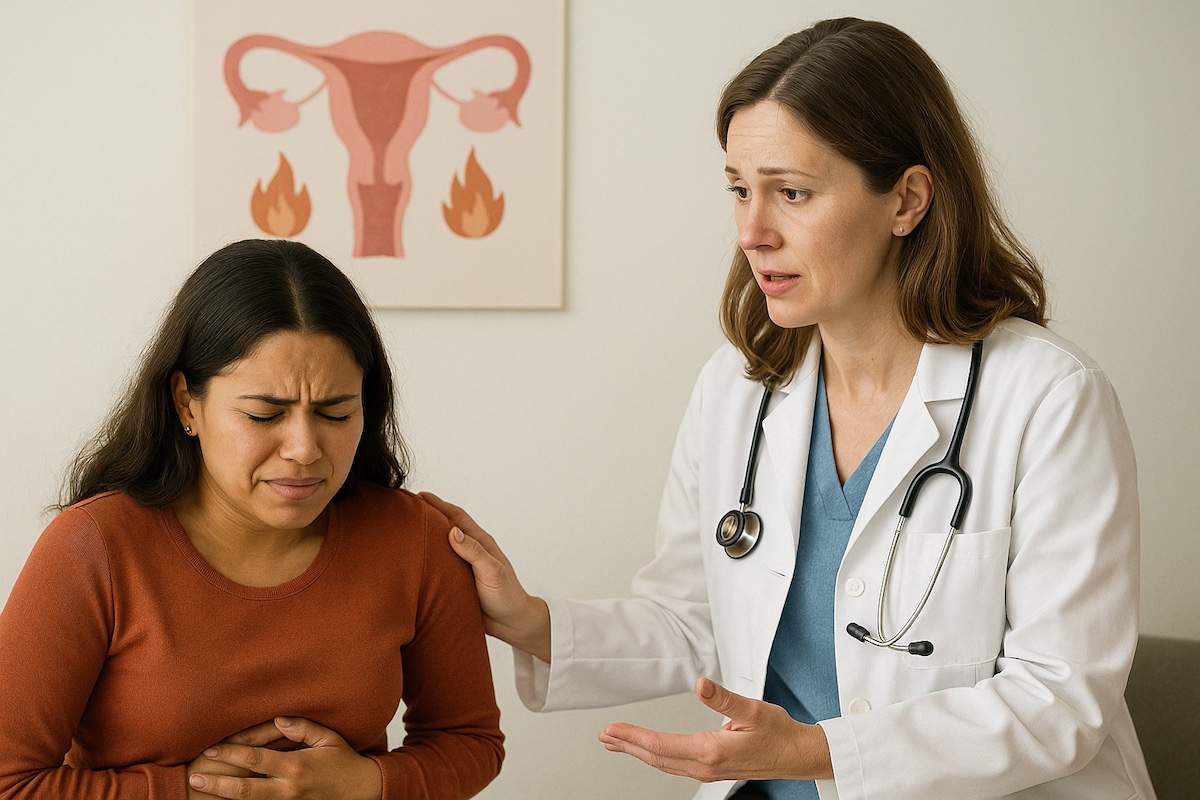Endometriosis is a chronic condition that affects millions of women worldwide, yet it is often misunderstood. For those living with it, one of the most challenging aspects is dealing with flare-ups—periods when symptoms like pain, fatigue, and digestive issues suddenly become more intense.
These flare-ups can interfere with work, relationships, and everyday activities, making it crucial to understand when they happen and how to manage them.
In this article, we’ll explore the most common triggers of endometriosis flare-ups, what symptoms to look out for, and practical strategies to help manage them.
Understanding Endometriosis Flare-Ups
A flare-up refers to a sudden increase in symptoms, especially pain, that can last from a few hours to several days. While people with endometriosis may experience ongoing discomfort, flare-ups are usually more severe and harder to control.

These painful episodes often occur when the body reacts to certain triggers, such as hormonal changes, stress, or diet. Recognizing what a flare-up feels like—and what might be causing it—is the first step toward finding relief.
Common Triggers of Endometriosis Flare-Ups
Hormonal Changes
Hormones play a huge role in endometriosis. Many women notice flare-ups around their menstrual cycle because estrogen levels rise and fall. Estrogen can stimulate endometrial tissue growth, which worsens pain and inflammation. Some also notice symptoms mid-cycle, during ovulation, when hormone levels shift again.
Diet and Food Sensitivities
What you eat can either help or aggravate endometriosis. Foods that trigger inflammation—like processed foods, red meat, dairy, caffeine, and alcohol—may worsen symptoms. Some women are also sensitive to gluten or high-sugar foods, which can cause bloating, cramping, and digestive problems.
On the other hand, anti-inflammatory foods such as leafy greens, salmon, and turmeric may reduce the risk of flare-ups.
Stress and Emotional Health
Stress doesn’t just affect your mood—it can directly impact your body. When stressed, the body produces more cortisol, which may affect hormone balance and increase pain perception. Many women report that high-stress periods often trigger or worsen flare-ups.
Lack of Sleep and Fatigue
Not getting enough rest weakens the immune system and makes the body more sensitive to pain. Poor sleep also increases inflammation, which may contribute to more frequent or intense flare-ups.
Environmental Factors
Some people with endometriosis notice that changes in weather—such as cold, damp, or humid conditions—can worsen symptoms. Exposure to environmental toxins or chemicals may also influence hormone levels and trigger flare-ups.
Physical Activity and Movement
Exercise can be both helpful and harmful. Gentle, regular movement often reduces symptoms, but overexertion or high-intensity workouts can trigger a flare. On the other hand, being too sedentary may cause stiffness and worsen pelvic pain.
Other Health Conditions
Endometriosis often occurs alongside other health issues, such as irritable bowel syndrome (IBS) or autoimmune conditions. These can make flare-ups more unpredictable and difficult to manage. Scar tissue from previous surgeries may also contribute to pain.
Recognizing Symptoms of a Flare-Up
Flare-ups don’t look the same for everyone, but common symptoms include:
- Severe pelvic or abdominal pain
- Intense cramping, especially during menstruation
- Lower back and leg pain
- Fatigue and exhaustion
- Digestive issues like bloating, constipation, or diarrhea
- Emotional symptoms such as anxiety, irritability, or depression
Tracking these symptoms can help you spot patterns and anticipate flare-ups.
How to Manage Endometriosis Flare-Ups
Lifestyle Adjustments
Managing stress is one of the best ways to reduce flare-ups. Practices like meditation, deep breathing, and yoga can help calm the nervous system. Gentle daily movement, such as walking or stretching, also helps keep the body flexible and reduce stiffness.
Creating a sleep routine—going to bed and waking up at the same time each day—improves rest and reduces fatigue-related flare-ups.
Diet and Nutrition Strategies
Shifting to an anti-inflammatory diet can make a big difference. Focus on whole foods such as vegetables, fruits, lean proteins, and healthy fats. Omega-3-rich foods like fish and walnuts may help reduce inflammation.
Keeping a food journal can be helpful for spotting personal triggers. For instance, if you notice symptoms worsen after dairy or gluten, you can make informed changes. Staying hydrated throughout the day also helps digestion and reduces bloating.
Medical and Professional Support
Sometimes lifestyle changes aren’t enough. Over-the-counter pain relievers like NSAIDs can help manage pain, while doctors may prescribe hormonal treatments such as birth control pills, IUDs, or GnRH agonists to regulate symptoms.
For more severe cases, consulting a gynecologist or endometriosis specialist is essential. They can provide advanced treatment options, including surgery.
At-Home Remedies
Simple home remedies often bring immediate relief during flare-ups. Heat therapy—using a heating pad or warm bath—relaxes muscles and eases cramping. Gentle stretches and relaxation techniques may also help. Herbal teas such as chamomile, peppermint, or ginger can reduce bloating and soothe the digestive system.
Long-Term Management Strategies
Since endometriosis is a chronic condition, long-term strategies are essential. Keeping a symptom diary helps you connect patterns between diet, lifestyle, and flare-ups.
Creating a personalized management plan that includes medical care, diet, and stress management can improve overall quality of life. Support groups and counseling also provide emotional strength and community support, which is especially valuable for coping with flare-ups.
When to See a Doctor
Not all flare-ups can be managed at home. It’s important to seek medical attention if:
- Pain becomes too severe to manage with over-the-counter medication.
- Symptoms worsen over time or become more frequent.
- Flare-ups significantly interfere with daily life.
In these cases, a doctor may suggest advanced treatments like laparoscopy to remove endometrial growths or stronger hormonal therapies.
Conclusion
At Clinton Women’s Healthcare, we understand how difficult living with endometriosis can be. Flare-ups can disrupt your daily life, but with the right guidance, they can be managed effectively. Our compassionate team of physicians specializes in advanced gynecological care, including laparoscopic and robotic surgeries, hormonal treatments, and personalized management plans tailored to each woman’s unique needs.
We are committed to making every patient feel heard, respected, and supported. If you’re struggling with endometriosis flare-ups, know that you don’t have to face them alone. At Clinton Women’s Healthcare, we are here to walk with you every step of the way, helping you find relief and regain control of your health.
FAQs About Endometriosis Flare-Ups
How long do endometriosis flare-ups usually last?
Flare-ups can last anywhere from a few hours to several days. The length often depends on the trigger, hormone levels, and individual health conditions.
Can endometriosis flare-ups be prevented?
While it may not be possible to prevent every flare-up, many women find relief by avoiding known triggers, following an anti-inflammatory diet, managing stress, and getting enough rest.
Is it normal to have digestive problems during a flare-up?
Yes. Digestive symptoms like bloating, constipation, or diarrhea are very common during flare-ups, especially if endometriosis affects areas near the intestines.
Do flare-ups only happen during menstruation?
No. While flare-ups are often linked to the menstrual cycle, they can also happen at other times, such as during ovulation, after intense physical activity, or during periods of high stress.
When should I seek medical help for a flare-up?
You should see a doctor if pain becomes unmanageable with over-the-counter medicine, if flare-ups are interfering with daily life, or if symptoms keep getting worse. A specialist can help you explore advanced treatments for better long-term management.
Related Reading
